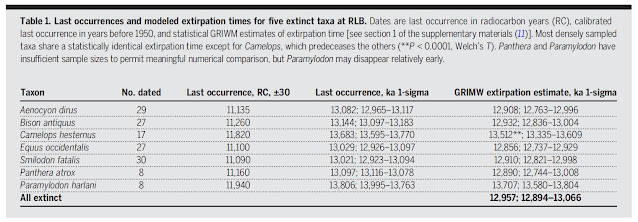O'Keefe et al.'s recent work on megafaunal extinctions is consistent with and supports the YDIH
Image of wildfire-induced megafaunal extinctions near the YD onset, from O'keefe et al. (2023). Does it look familiar?
O'Keefe et al. (2023) recently produced the most accurate data on N. American megafaunal extinctions near the onset of YD cooling yet published. The title of their work published in the prestigious journal Science reads "Pre–Younger Dryas megafaunal extirpation at Rancho La Brea linked to fire-driven state shift", making it clear they consider these fires to occur before the YD climate change. Yet their data fully supports the Younger Dryas impact hypothesis (YDIH). So where did they go wrong? And how did this get published?
Briefly, they radiocarbon dated over 170 samples from animal bones in the Rancho La Brea tar pits, and then used a statistical model to estimate the extinction dates of 7 species found trapped in them. This is just a subset of all the species represented in these tar pits, but nevertheless is a reasonable sample. They compared these estimated extinction dates with a charcoal record from a lake sediment core from a lake (Elsinore) around 100 km to the south of the tar pits. As the extinctions seem to coincide temporally with a massive increase in charcoal in the lake sediment, they concluded, "Seven species of extinct megafauna disappeared by 12.9 ka, before the onset of the Younger Dryas. Comparison with high-resolution regional datasets revealed that these disappearances coincided with an ecological state shift that followed aridification and vegetation changes during the Bølling-Allerød (14.69 to 12.89 ka). Time-series modeling implicates large-scale fires as the primary cause of the extirpations, and the catalyst of this state shift may have been mounting human impacts in a drying, warming, and increasingly fire-prone ecosystem."
But this sounds just like the YDIH. What's going on?
Above is their main result for the extinction dates of 7 species found in the tar pits. Notice the age uncertainty is at 1-sigma. So at the level of 2 sigma, their date range for 5 of the extinctions, presuming synchroneity, is 12,957 +- 172 BP, or 12,835 - 13,179 BCE (using the latest radiocarbon calibration, and assuming a normal error distribution). The proposed date of the YD impact event is 12,825 +- 50 yr BP (2 sigma, according to Cheng et al. (2020), updated from Kennett et al. (2015) using the latest radiocarbon calibration). Thus, O'Keefe's result is perfectly consistent with the YDIH at the level of 2 sigma, which presumably means most of the tar pit extinctions are consistent with the YDIH.
Above is their reconstruction of wildfire intensity deduced from the Lake Elsinore sediment core. Charcoal abundance is plotted vs time (kyr BP). But recall the uncertainty in these dates is around 170 years at 2 sigma. So the massive charcoal event around 12,950 yr BP is completely consistent with and supports the YDIH. To conclude this charcoal spike and megafaunal extinction event occurs before the YD onset they have to ignore the uncertainty in their data, which is bad science. Were the referees asleep?
But how rigorous is their age-depth model for this lake core?
O'Keefe et al.'s age-depth model deduced for Lake Elsinore is plotted above. There are only a few radiocarbon samples from near the YD onset (~1550 cm), so their age-depth model is low quality and could easily be out by hundreds of years in this region. In other words, I would have low confidence in their age-depth model. Nevertheless, their age-depth model displays considerable uncertainty around the YD onset and their data clearly supports the YDIH. Yet no YDIH papers are cited in their paper. Why not? I have no problem with introducing new hypotheses, but ignoring established ones that also explain the observed data is bad science.
We have seen this kind of biased reporting before, e.g. Gill et al. (2009). Like O'Keefe et al. (2023), they concluded their results contradict the YDIH, but when examined closely their data fully supports the YDIH. Like O'Keefe et al., to make their conclusion they had to ignore the uncertainty in their age-depth model. It's almost as though there's a concerted effort by some research communities to trash the YDIH 😉 (note, both O'Keefe et al. (2023) and Gill et al. (2009) are published in the journal Science). Yet the evidence, when interpreted properly, always seems to support it.
Recall that Holliday et al. (2023) just published a "comprehensive refutation" of the YDIH a few weeks before O'Keefe et al (2023). In their refutation they insist many times there is no evidence for megafaunal extinctions near the YD onset. Yet the data speaks for itself.
------------------------------------------------
O'Keefe et al., Science 381, eabo3594 (2023).
Gill et al., Science 326, 1100 (2009).
Holliday et al., Earth Science Reviews (2023, pre-print)







Comments
Post a Comment